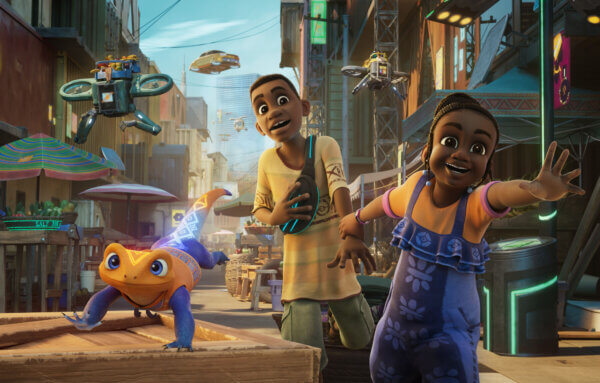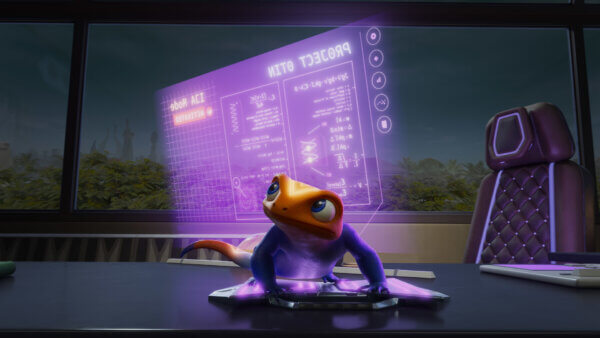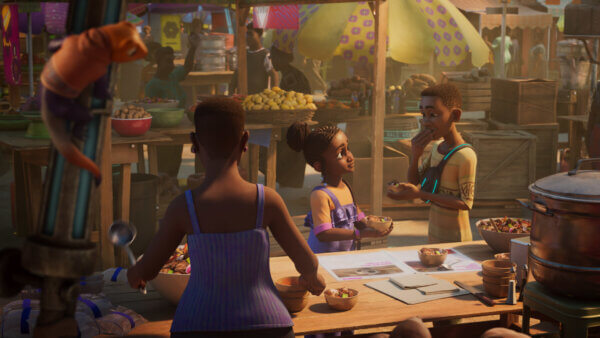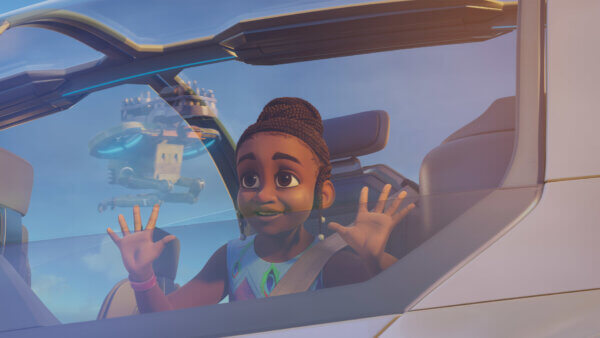Toluwalakin Olowofoyeku, Hamid Ibrahim & Marlon West on Iwájú
Some of Disney’s most famous stories are set in Africa. Tarzan and The Lion King are core to the Disney renaissance library, but depict a version of the continent shaped by white people. Neither film spends much time away from the jungle or the desert, showing the truth of the life and people of Africa. Iwájú marks the first time Disney have collaborated with an African studio on a full series and therefore feels like the most heartfelt and truthful depiction of an African country in a Disney story.
The African studio in question is Kugali Media, a creative enterprise that has roots in comics, TV and film and connects artists from the entire continent. Its co-founders Hamid Ibrahim, Tolu Olowofoyeku and Olufikayo Adeola take a hands-on approach with their projects, serving as the production designer, producer, and writer/director on Iwájú respectively.
The show takes place in a futuristic version of Nigeria, where we get acquainted with its eccentric technologies (including a superpowered robot lizard), its energised protagonist Tola, and its dark, criminal underworld. Bringing that vision to life is Marlon West, VFX supervisor and effects animator at Disney since the 90’s. With credits including The Lion King, The Emperor’s New Groove and Encanto, West’s understanding of the Disney voice enabled a harmonious marriage between these two studios.
Skwigly caught up with Ibrahim, Olowofoyeku and West to discuss Iwájú’s unique visual identity and its depiction of Nigeria.
How did this series originate? Where does the idea for a future Nigeria come from and who invented the robot lizard?
Toluwalakin Olowofoyeku: I’ll be speaking on behalf of my co-founder, Ziki, who’s not here, because he’s the writer. Ziggy grew up in Nigeria for the first 15 years of his life and relocated to the UK. He realised that he wanted to be able to show his UK friends what Lagos was like. So a few years before we met with Disney Animation, he already had the story in his head, a story set in Lagos. Once we started speaking with Disney animation, and we got the opportunity to pitch multiple stories, this was one of the stories he put forward. I still live in Lagos, I’ve spent my whole life in Lagos, and I was hoping they would pick this one so that I would get to show people some of the quirks of Lagos.
About the lizard, it’s funny, in the original pitch there was no lizard. Originally, we said, ‘The girl has a robot pet that protects her.’ We didn’t know the robot pet was going to be a lizard at the time. By default, we just assumed it to be a dog. But we wanted something that can follow her around and hide easily and in certain settings, a dog would look out of place. But in Lagos, there’s almost no setting we’re an agama lizard looks out of place. I see one almost every single day of my life. Another reason we picked an agama is because as soon as you see it, you think of Nigeria.
Hamid Ibrahim: In terms of design aspects, it mostly came from thinking of real life Lagos, and using tech to exaggerate the nuances that we find interesting and also to just go with how the world would evolve naturally.
Marlon, how did your work fit into what these guys had envisioned?
Marlon West: My job as a visual effects supervisor was to bring the Disney quality to what they had in mind. So we had artists from Disney working on it, they had artists from Kugali who came in from comics, we had people working in film for the first time working on it. What we were trying to create was something that was unique, but at a very, very high quality as well. We wanted it to stand alongside any other Disney products that I’ve worked on in the three decades that I’ve been at the studio.
Kugali has its hands in so many different types of media, do you see projects like this as a chance to train up artists?
HI: That’s the whole Kugali ethos. I don’t look at the industry in silos. It is just my personal philosophy. Even when we bring in people who are more experienced, and they’re looking at the Kugali process, a lot of them are like, ‘No, one person should have one job.’ I’m like, ‘No, the pipeline is varied and it crosses all the way through.’ So in Kugali, with everybody who has been with us, let’s say you’re a 3D modeller, that means you’ll be really good at other aspects in CG specifically. Let’s say you used to be a comic book artist, I don’t look at you as a comic book artist, I look at you as an artist who can draw sequentially. That means we’ve got some of those people to come on storyboards. That’s always been my mentality. What’s the principle of the thing they do versus what’s the role they have? Can the thing they do be used in this place and be better? The world is always evolving and Kugali is always innovating.
Were there any wrongs you wanted to put right when thinking about Africa’s representation in western media?
TO: I wouldn’t see so much as wrongs put right, but there’s a difference between when someone else tells your story and when you tell your story yourself. The resources to tell good quality stories in animation have typically been in the Western world, and to an extent in the East, but not really in Africa. That’s why you have Nollywood, which I believe is the second largest film producer in the world, after Bollywood. Nollywood produces so many movies, but no animation. So the fact that we, an African storytelling company, goes to collaborate with a Western company that has the resources to tell the story in animation at this scale, meant that they empowered us to be able to tell our own story by ourselves, which is why the characters sound like us, and talk the way we do, rather than sounding like maybe an American trying to portray a Nigerian voice.
MW: I think it was very important to actually empower what they were trying to do. We ran everything by Tolu because there are things that a story artist, or an animator might do at Disney that seems right to us. But it was good to actually show blocking to Tolu, to show rough cuts of the show to other people, because we wanted it to be authentic. We knew it even for films before Iwájú that I’ve worked on. We tried to do right by the people who have hosted us, whatever island that they live in, whatever city that they live in, who bring us into their homes. We try to make these things universal for people so you can go out and touch people all around the world, but they need to be specific and right to the people who know. That’s always been important to me throughout my entire career and that was something that I definitely wanted to bring to this project so the people who live in Lagos know we did it right.
The look of the show lines up well with a lot of recent Disney features, is that something Marlon brought?
MW: Hamid had a look that he wanted to do and what we brought was quality. To me, if you stand Tola next to Elsa or Moana, she looks of a quality but she’s not from the same world. That was important. We were trying to do something unique, the way we designed the characters and the way that we lit them was a little different than other films that we’ve worked on because it was something that Hamid was trying to create as a visual storyteller.
HI: I want to put something out there, in terms of lighting the character and their skin. I want you to look around every single CGI animated show, I promise you no other characters look as good who are as dark as Tola. That was one thing we had to iterate on to try and get right and natural. People have been lighting characters for a very long time and if it’s a lighter skinned character, you try to blast the light at them as much as possible to get the shape. But if you’re adding any extra light when somebody’s skin is dark, you lose the depth of the skin and you lose how dark it is. If you get every single character that you think is really dark and then put them next to Tola, you will notice Tola is darker. I’m willing to put a bet online, find it for me. I want to see it!
Iwájú is now streaming on Disney+





